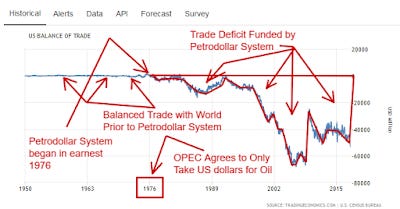Trump Bypasses the Circle of Loot
In last week’s column, I described how world demand for US dollars has been sustained by virtue of the petrodollar agreement between the US and the Saudis, as well with most other OPEC countries. That agreement ushered the means by which the US has been able to print unlimited numbers of dollars, borrow them into existence, and send them to producer countries in payment for valuable products from all over the world. Only in America can a people print money out of thin air and expect other peoples to take them as payment for valuable items. But they do, which explains how the US has been able to sustain a monstrous annual trade deficit for the last several decades.
In case you missed last week’s column, the petrodollar system is very simple. The countries of the world must have dollars to buy OPEC energy. That creates demand for dollars around the world. To gain access to dollars, countries must sell us their stuff. To pay for the stuff, Wall Street prints more and more dollars; Americans borrow them, going further and further into debt. Producer countries take those borrowed dollars as payment for goods they produce, and use them to purchase OPEC energy. OPEC countries then deposit their dollar revenues right back into the same Wall Street banks that issued them, new deposits becoming reserves to back the printing of even more dollars. A good friend once described this kind of operation as a “circle of loot,” a term I appropriately choose here.
Beyond simply funding this circle of loot, OPEC and the producer countries of the world take dollars for which they have little alternative use and purchase US Treasuries, helping to fund our federal Government. Foreign holdings of US treasuries presently comprise approximately one-fifth of our national debt, virtually all from petrodollars.
Petrodollar System Funds the Trade Deficit
So the petrodollar system funds the US trade deficit, Wall Street banks, and the US Government. While Wall Street and OPEC get wealthier, the American people go more into debt buying cheap stuff from overseas, and the US government goes more into debt to foreign countries. Also, because dollars are so plentiful around the world, and largely untaxed by the US Government, American industries have taken to laying off their workers, leaving our shores and setting up shops in foreign countries where governments allow them to operate virtual sweat shops, under lax environmental standards, and minimal taxation, producing their products under the least costly conditions.
Another term for the, “circle of loot” is, “free trade.” Regardless what you thought “free trade” might be or should be, the system I describe is what those who promote it desire it and design it to be. “Free trade,” under their terms, is the means by which private financial institutions “freely” indebt entire populations, such as ours, and “freely” transfer the wealth of nations to themselves. And they do it largely by controlling national currencies and the international trading currency, the petrodollar.
Crisscrossing the globe are networks of financial circles of loot, or, “free trade zones,” large and small. At the hub of these networks are private central banking systems, such as the Federal Reserve, operating in and among virtually all western industrialized countries. Connecting and promoting these operations are the International Monetary Fund (IMF), the World Bank and the Bank of International Settlements (BIS), a sort of “central bank for central banks.” Together these institutions comprise a veritable worldwide banking cartel, controlling the currencies for the nations in which they operate.
The glue that holds the cartel together is the petrodollar. But because new sources of energy are coming online throughout the world, the influence of the petrodollar is waning. Thus, the cartel’s power and control over the nations is diminishing as well.
To deal with the natural demise of the petrodollar, the cartel is planning an international monetary “reset,” imposing a new cartel-issued international currency to take the place of the petrodollar around the world.
Thankfully, President Trump understands the cartel’s plan and stands against it. Trump’s economic policies end run the petrodollar, his purpose to insulate America from economic upheaval brought on by its demise. For Trump to be successful though, the US economy must be able to operate substantially on its own. To do that, Trump must restore our domestic industries and develop new internal sources of energy. Just last week Trump announced his policy for America to not only become a net energy exporter, but to actually “dominate” the world in energy production, creating real economic demand for the US dollar to replace coercive and increasingly obsolete petrodollar demand.
The cartel understands what Trump is up to and does not like it at all. They have been using their control of mainstream media to resist his purposes. That explains all the fake news. Thankfully, Trump is winning. But the danger is that the cartel will undertake extraordinary means to retain power and control, a prospect which, very frankly, could mean practically anything.




